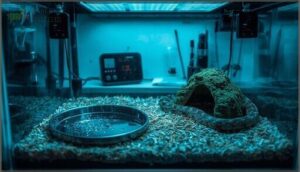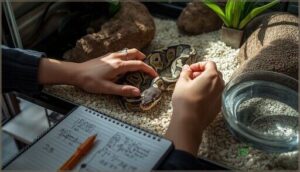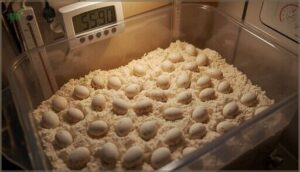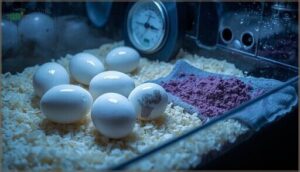This site is supported by our readers. We may earn a commission, at no cost to you, if you purchase through links.
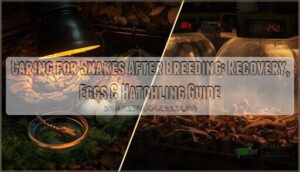
Breeding snakes successfully doesn’t end when eggs appear in the nesting box—it kicks off one of the most demanding phases of reptile husbandry. Female snakes often lose 20–30% of their body weight during egg production, leaving them vulnerable to infection, dehydration, and metabolic collapse if you don’t intervene quickly.
Meanwhile, males can suffer injuries from mating attempts, and hatchlings face mortality rates above 40% without precise environmental controls.
Caring for snakes after breeding demands vigilance across multiple fronts: restoring the female’s depleted reserves, preventing egg binding complications, maintaining exact incubation parameters, and ensuring hatchlings shift smoothly to independent feeding. Each stage carries distinct risks that require targeted strategies.
Table Of Contents
- Key Takeaways
- Immediate Post-Breeding Snake Assessment
- Setting Up The Optimal Recovery Enclosure
- Nutrition Strategies for Post-Breeding Snakes
- Daily Observation and Health Monitoring
- Caring for Snake Eggs After Laying
- Snake Egg Incubation Essentials
- Supporting Female Snake Recovery
- Hatchling Snake Care and First Feedings
- Frequently Asked Questions (FAQs)
- Conclusion
Key Takeaways
- Female snakes lose 20–30% of their body weight during egg production and require two to four weeks of undisturbed rest with protein-rich prey (30–50% crude protein) and increased calcium supplementation to restore depleted reserves and prevent metabolic collapse.
- Post-breeding recovery demands precise environmental control, including temperature gradients of 75–92°F, humidity levels of 50–70%, and daily monitoring for egg binding, respiratory infections, and dehydration—complications that can escalate rapidly without intervention.
- Successful egg incubation requires species-specific temperatures (75–92°F depending on species), consistent 75–85% humidity, proper substrate moisture balance, and weekly candling checks to detect development issues before hatchling mortality rates exceed 40%.
- Hatchling survival depends on secure 7-liter enclosures with dual hides, waiting five to seven days post-hatching before first feeding appropriately-sized prey, and weekly growth monitoring to catch health problems early when mortality risks are highest.
Immediate Post-Breeding Snake Assessment
The hours after breeding are critical—this is when hidden complications surface and small problems can escalate quickly. Your snake’s body has just been through a physiological marathon, and what you do now sets the stage for recovery or trouble.
The hours after breeding are critical—hidden complications surface fast, and what you do now determines recovery or crisis
Before anything else, you need to assess three key areas that determine whether your breeding pair thrives or struggles.
Monitoring for Egg Binding and Complications
Vigilance during the post breeding care window can mean the difference between a healthy recovery and a veterinary emergency. Watch for egg binding signs like abdominal swelling, restlessness, or repeated digging attempts during the incubation period.
Since egg binding affects roughly 16% of breeding females, you’ll want to perform daily palpation checks to detect retained eggs early, protecting your snake’s reproductive health and preventing serious snake dystocia complications.
Understanding proper egg incubation techniques is vital for a successful breeding process.
Recognizing Signs of Stress or Illness
Beyond egg binding concerns, you’ll need to watch for behavioral changes that signal deeper trouble. Prolonged hiding, defensive hissing, or food refusal all point to stress that demands immediate attention.
Check for physiological signs like irregular shedding, abnormal respiratory rates, or weight loss exceeding 5% of body mass—these health monitoring markers help you catch illness detection early, before minor problems become critical threats to your snake’s recovery.
To minimize stress, consider implementing low stress techniques when introducing changes to their environment.
Distinguishing Male and Female Recovery Needs
While both sexes face post-breeding challenges, their recovery times and nutrient needs differ dramatically. Males usually resume feeding within 48–72 hours and bounce back quickly, but females endure prolonged stress factors—losing up to 32% of body mass and requiring two to four weeks of undisturbed rest.
These sex differences in hormonal changes mean your postbreeding care approach must adapt completely based on which snake you’re monitoring.
Setting Up The Optimal Recovery Enclosure
Your snake’s recovery enclosure isn’t just a holding space—it’s the foundation for rebuilding strength and preventing post-breeding complications. Getting the temperature, humidity, and substrate right can mean the difference between a smooth recovery and a trip to the emergency vet.
Let’s walk through the three critical elements you need to dial in before your snake settles into its recovery period.
Temperature Gradient and Humidity Control
Your post-breeding snake needs a controlled climate to bounce back safely. Temperature gradients between 75–80°F and 88–92°F let your snake self-regulate, while maintaining 50–70% humidity prevents dehydration and respiratory trouble.
Here’s what works:
- Use digital thermometers and hygrometers for accurate temperature monitoring
- Create thermal gradients with heat tape or ceramic emitters
- Calibrate sensors monthly to catch deviations early
- Maintain humidity levels through misting or water surface area
Substrate Choices for Comfort and Hygiene
Your substrate choice directly impacts snake habitat creation during recovery. Aspen shavings offer 62% absorbency rates and support humidity control, while coco coir retains up to 180% of its weight in water—critical for post-breeding reptile husbandry.
However, loose substrates carry microbial risks, showing 17% higher infection rates. Clean paper substrates weekly, organic materials every 10 days, balancing reptile enclosure management with your snake’s comfort during this vital incubation period shift.
Ventilation and Security Measures
Airflow management protects your recovering snake from respiratory infections while preventing costly escapes. Position vents low on the cool side and high on the warm end—this natural circulation pattern maintains climate control without compromising humidity.
Your secure enclosure needs:
- Wire locks on all sliding doors to eliminate accidental openings
- Two to three 5″x3″ vents for a 4-foot enclosure
- Monthly security checks on all potential escape routes
Nutrition Strategies for Post-Breeding Snakes
Your snake’s recovery depends on more than just rest—it needs the right fuel to rebuild what breeding took away. Female snakes, especially, face dramatic weight loss and depleted reserves that demand careful nutritional planning.
Here’s how to support their bodies through targeted feeding, proper supplementation, and hydration strategies that actually work.
Protein-Rich Diets for Females
After laying eggs, your female snake’s body is depleted—she’s lost critical muscle mass and protein stores. You’ll need to prioritize protein-rich diets containing 30–50% crude protein to rebuild her strength.
Focus on feeding vertebrate prey like mice, rats, or chicks, which provide complete amino acids essential for tissue repair and immune function.
Proper protein intake directly aids faster recovery, reduces egg-binding risks, and restores her body condition for future reproductive success.
Feeding Frequency and Prey Size Adjustments
Once your female starts eating again, you’ll need to recalibrate feeding schedules and prey selection to match her depleted condition. Offer smaller prey items—10–15% of her body weight—every 7–10 days initially, allowing full digestion within 48 hours.
As she regains strength, gradually adjust feeding frequencies and prey sizes based on her weight and appetite, ensuring ideal post-breeding nutrition without risking regurgitation.
Calcium and Supplementation Needs
Calcium deficiency poses a serious risk to post-breeding females, who’ve lost up to 40% of calcium reserves after laying eggs. You’ll need to restore bone health and prevent metabolic disease through strategic supplementation.
- Dust prey items with calcium powder containing Vitamin D3 for ideal absorption—commercial blends offer 8–10% elemental calcium
- Increase supplementation to 2-4 times maintenance levels during the 4–6 week recovery period
- Monitor feeding response and body condition, adjusting dietary balance based on weight gain
- Choose calcium carbonate or gluconate forms, ensuring proper snake nutrition without risking hypercalcemia
Hydration and Water Provision
Dehydration risks escalate dramatically after breeding—water-deprived females lose considerably more body mass and total water than hydrated controls, directly threatening snake health.
You’ll need to provide abundant fresh water daily for rehydration strategies, as reproductive females rapidly absorb water proportional to offspring numbers. Monitor water intake closely during recovery, and consider soaking practices to aid hydration essentials through skin absorption, supporting superior reptile care and preventing physiological stress.
Daily Observation and Health Monitoring
Once your snake has eaten and settled into its recovery enclosure, your real work begins with daily observation. Watching for subtle changes in behavior, body condition, and overall vitality can mean the difference between catching a problem early and facing a veterinary emergency.
Let’s break down the three essential areas you need to monitor every single day.
Detecting Early Signs of Infection or Disease
Vigilance becomes your best diagnostic tool during the critical recovery window. Watch for lethargy, anorexia persisting beyond a few days, or abnormal tongue flicking—early markers that something’s wrong.
Respiratory infections often announce themselves through wheezing or open-mouth breathing, while egg binding presents as restlessness and straining.
Regular health screening, including oral and cloacal swabs when needed, aids infection control and catches problems before they escalate into emergencies requiring intensive veterinary care.
Monitoring Weight Loss and Body Condition
You’ll need to track weight loss patterns closely, as female snakes commonly shed around 40% of their body mass through the breeding cycle. Weigh your snake weekly, documenting changes to establish baseline fat reserve management and condition scoring.
Postpartum nutrition becomes critical when body mass drops exceed 6.3% within six weeks—this signals you need to adjust feeding strategies immediately to support postbreeding recovery and maintain your snake’s health and wellbeing.
Assessing Hydration and Activity Levels
Watch your snake’s hydration status and movement patterns just as carefully as weight—sunken eyes, wrinkled skin, and sticky saliva signal dehydration in over 60% of cases. Activity tracking helps too, since 80% of properly hydrated snakes resume normal behavior within a week.
- Check for dull scales or retained shed, appearing in roughly 72% of dehydrated individuals
- Maintain 50–70% humidity for ideal recovery metrics and snake health and wellbeing
- Monitor daily water intake, as fresh access reduces dehydration risk by 85%
Caring for Snake Eggs After Laying
Once your female has finished laying, the eggs need your immediate attention to survive. Handling them carefully and setting up the right incubation environment can mean the difference between healthy hatchlings and total loss.
Here’s what you need to do to give those eggs their best shot at development.
Safe Egg Collection and Handling
Once your snake lays eggs, collect them within 24 hours to guarantee viability. Check the lay box daily, handling each egg gently without turning it—studies show turned eggs have much higher mortality rates.
Keep stuck eggs grouped together, maintain their original position, and disinfect your hands before collection. Proper egg sanitation and handling techniques during this critical window set the foundation for successful snake egg incubation.
Setting Up Incubation Containers
Your egg container acts as a miniature climate sanctuary, demanding precision in every element. Follow these steps for proper incubation setup:
- Select airtight plastic tubs sized appropriately for your clutch without crowding
- Fill three-quarters full with vermiculite or perlite as incubation mediums
- Press shallow indents to cradle each egg without burying them
- Maintain species-specific incubation temperature between 78°F and 92°F
- Target 90-100% humidity control while ensuring minimal gas exchange through sealed lids
Regular monitoring with thermometers and hygrometers ensures stable conditions throughout the incubation period.
Preventing Mold and Egg Collapse
Despite your careful incubation management, mold appears when humidity control exceeds 95% or ventilation fails. You’ll prevent fungal growth by maintaining 80-95% relative humidity and spacing eggs to block contamination spread. Isolate moldy eggs immediately, then apply antifungal powders containing miconazole to affected shells.
Your substrate should clump without dripping—excess moisture invites the egg collapse and egg binding complications you’re working to avoid.
Snake Egg Incubation Essentials
You’ve collected the eggs, set up the incubation containers, and now comes the most critical phase: maintaining the exact conditions those eggs need to develop. Getting temperature, humidity, and substrate right isn’t optional—these three factors determine whether you’ll have healthy hatchlings or heartbreak in 55 to 75 days.
Let’s break down each element so you can create an incubation environment that gives your eggs the best shot at success.
Temperature and Humidity Requirements
Your incubation success depends entirely on precision with temperature and humidity control. Thermal gradients and environmental monitoring aren’t optional—they’re the difference between viable hatchlings and failed clutches.
- Set species temperature ranges accurately: ball pythons need 86-92°F, corn snakes 78-84°F, and king snakes 75-82°F during the incubation period.
- Maintain 75-85% humidity using digital hygrometers placed inside incubation containers.
- Monitor egg incubation conditions daily to catch fluctuations before damage occurs.
- Adjust heat sources gradually—never make sudden temperature shifts during development.
Choosing and Preparing Substrate
Your substrate choice can make or break incubation success. Vermiculite and perlite are sterile, moisture-retentive options that prevent mold, while coconut coir offers eco-friendly humidity control. Sphagnum moss brings natural antimicrobial properties.
Mix substrate with water until it clumps without dripping—that’s your ideal moisture balance. Keep substrate depth at 3-4 inches for proper aeration, and never let it become waterlogged.
Monitoring Egg Development and Viability
You can’t trust eggs to tell their own story—active monitoring makes all the difference. Egg candling between days 7 and 14 reveals visible veins and embryo movement in fertile eggs, while infertile ones appear opaque.
Weekly viability checks let you track development and catch problems early. Maintain incubation temperature between 88-92°F with humidity at 75-85% to prevent egg binding complications and guarantee healthy embryo monitoring throughout the 45-70 day development period.
Supporting Female Snake Recovery
Female snakes face months of physical strain during the breeding cycle, often losing nearly half their body weight by the time eggs are laid.
Getting your female back to full strength takes patience, careful feeding, and a low-stress environment that lets her recover at her own pace.
Here’s how to support her through each stage of post-laying recovery.
Managing Post-Laying Weight Loss
Female snakes often lose 600 to 800 grams after laying eggs, making weight loss prevention a cornerstone of postbreeding recovery. You’ll need to track body condition closely and support female snake rehabilitation through strategic interventions:
- Weigh your snake weekly to monitor recovery trends
- Offer protein-rich prey items within 48 hours post-laying
- Provide smaller, frequent meals for easier digestion
- Maintain ideal temperature gradients for metabolism
- Monitor hydration status through skin elasticity checks
Recovery timeframes usually span several weeks with proper post laying nutrition and dehydration management.
Rest and Stress Reduction Techniques
You’ll want to minimize handling to once weekly or less—frequent interaction raises stress hormones by 23% and delays postbreeding recovery.
Environmental enrichment like deeper substrates and secure hides cuts defensive behaviors by 54%, while consistent routines lower abnormal stress responses by 35%.
Calming techniques such as reducing room noise decrease rapid heart rate episodes by 31%, supporting animal welfare and relaxation methods during this vulnerable recovery phase.
When to Resume Normal Feeding Schedules
Once your snake’s stress levels settle, you can start thinking about feeding triggers and post-lay nutrition. Most females resume snake feeding within 7 to 14 days after laying, with 65–80% accepting meals by the first week.
Recovery timing varies—watch for strong feeding responses and normal bowel movements before returning to regular snake diet intervals, usually 10 to 14 days for most species.
Hatchling Snake Care and First Feedings
Once your hatchlings emerge, they need a secure space that encourages feeding and minimizes stress during those critical first weeks. The right enclosure setup makes all the difference between confident eaters and problem feeders.
Here are the key components you’ll need to establish for successful hatchling care.
Setting Up Hatchling Enclosures
A proper enclosure starts with a small tub—around 7 liters—because hatchling snake care thrives on security, not space.
You’ll need dual hides for temperature control, a heated zone covering one-third of the enclosure design, and a sturdy water bowl.
Paper towel substrate simplifies hygiene for hatchlings, while ventilation systems with drilled holes balance humidity management without sacrificing warmth or reptile enclosure management precision.
Timing and Selecting First Meals
Once your hatchling settles into its enclosure, first feed timing becomes your priority—wait five to seven days after hatching, or ideally until after the initial shed when feeding hatchling snakes is safest.
Prey selection demands precision for hatchling nutrition success:
- Choose pinkie mice matching the snake’s girth for manageable meal sizes
- Offer meals every five to seven days on consistent feeding schedules
- Watch for regurgitation before adjusting feeding habits or hatchling snake care protocols
Tracking Growth and Health in Hatchlings
Growth monitoring starts with weekly weigh-ins and feeding logs—you’ll track healthy growth by recording weight gains of roughly 30% per feeding session.
Health checks reveal critical issues early: examine skin condition for dehydration signs, assess tongue flicking for neurological function, and inspect the glottis for discharge.
Mortality rates climb when you miss subtle cues, so maintain detailed development tracking records documenting every meal, shed, and behavioral change in your hatchling snake.
Frequently Asked Questions (FAQs)
Can breeding shorten a snakes overall lifespan?
Frequent reproductive cycles correlate with reduced longevity across species. Studies reveal breeding females face heightened mortality rates and accelerated senescence effects.
High breeding frequency consistently links to shortened lifespans in reptile care populations.
How long before attempting to breed again?
Most female snakes require a full two-year breeding interval for complete postpartum care and reproductive cycles recovery.
Only 8% attempt annual rebreeding strategies, while 63% follow biennial patterns, ensuring restored body condition before the next breeding season.
Do males require separation after successful mating?
Yes, males should be separated immediately after successful mating. Breeding pairs kept together face male-to-male aggression and post-mating stress, while separation benefits include faster male recovery, reduced injury rates, and improved breeding strategies for the next breeding season.
What vaccines or preventatives exist for breeding snakes?
No vaccines are licensed for snakes as of Disease prevention relies on quarantine protocols, antiparasitic treatments, hygiene practices, and veterinary monitoring—not immunization strategies used in mammalian reptile health management.
Should lighting schedules change during post-breeding recovery?
Think of lighting as a reset button for your snake’s internal clock. Photoperiod adjustment is essential during post-breeding recovery, helping hormonal recovery and behavioral normalization through careful light cycle management and environmental enrichment.
Conclusion
A Kenyan sand boa breeder once lost an entire clutch—not from incubation errors, but because the exhausted female developed a respiratory infection three days post-laying that went unnoticed.
Caring for snakes after breeding isn’t a checklist you complete; it’s a continuous chain where one weak link collapses everything downstream. Your vigilance during recovery directly shapes whether eggs develop properly and hatchlings thrive.
Every observation, every adjustment, protects the entire lineage you’ve worked to create.
- https://www.sciencedaily.com/releases/2018/03/180314102010.htm
- https://pmc.ncbi.nlm.nih.gov/articles/PMC6511386/
- https://www.thebreedinglab.com/food-cycle
- https://www.nationalgeographic.com/animals/article/python-mothers-care-for-young-southern-african-snakes-spd
- https://journal-of-herpetology.kglmeridian.com/view/journals/hpet/53/4/article-p282.xml

